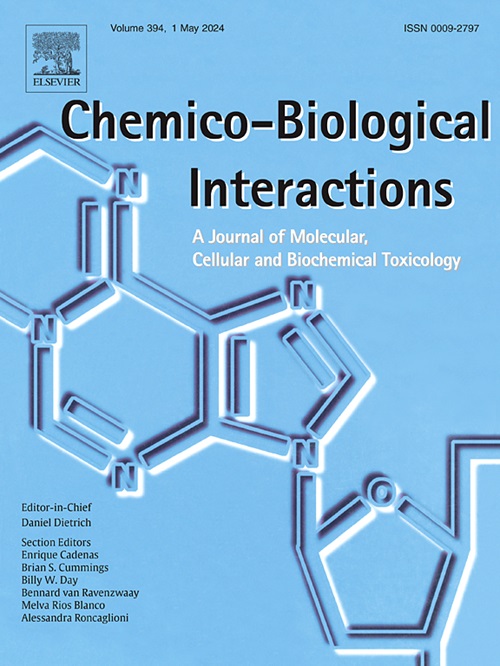胆碱酯酶活性调节剂:十二烷基氨基喹啉作为人乙酰胆碱酯酶和BChE抑制剂的评价。
IF 4.7
2区 医学
Q1 BIOCHEMISTRY & MOLECULAR BIOLOGY
引用次数: 0
摘要
在这项研究中,我们研究了新型十二烷基氨基喹啉(QAs)对神经递质水解酶,特别是乙酰胆碱酯酶(AChE)和丁基胆碱酯酶(BChE)的抑制活性。根据我们之前的发现,我们修改了先导化合物的结构,以开发更有效的胆碱酯酶活性调节剂。寻找此类抑制剂仍然是有机磷中毒和各种神经系统疾病治疗管理的关键焦点。在设计中,我们保留了脂肪族侧连接剂,并在喹啉核心上引入了各种苯基取代基,从而得到了11个新化合物。所有这些衍生物在微摩尔浓度范围内均表现出可逆的胆碱酯酶抑制作用。影响抑制作用最显著的因素是苯环上特定基团的位置变化,从元位转移到对位。具体来说,在中间位置具有基团的类似物对AChE的抑制作用更强,而对BChE的抑制作用更有效。最有效的抑制剂具有-CH3或-Br取代基,AChE的Ki值约为1.7-2.0 μM(位),BChE的Ki值约为0.3-0.5 μM(位)。此外,我们评估了这些化合物对人体神经元SH-SY5Y细胞的细胞毒性,作为它们在体内的预定靶点。在1.5 ~ 17 μM范围内,喹核啶衍生物均表现出一定程度的细胞毒性,需要进一步的研究来探索这种效应,并验证或否定其作为治疗剂的潜力。本文章由计算机程序翻译,如有差异,请以英文原文为准。
Cholinesterase activity modulators: Evaluation of dodecylaminoquinuclidines as inhibitors of human AChE and BChE
In this study, we investigated the inhibitory activity of novel dodecylaminoquinuclidines (QAs) on neurotransmitter-hydrolyzing enzymes, specifically acetylcholinesterase (AChE) and butyrylcholinesterase (BChE). Following our previous findings, we modified the structure of a lead compound to develop more potent modulators of cholinesterase activity. The search for such inhibitors remains a key focus in the therapeutic management of organophosphate poisoning and various neurological disorders. For the design, we retained the aliphatic side linker and introduced various benzyl-based substituents to the quinuclidinium core, resulting in a set of 11 new compounds. All of these derivatives exhibited reversible inhibition of cholinesterase within the micromolar concentration range. The most significant factor affecting inhibition was the positional change of a specific group on the benzene ring, shifting from the meta to the para position. Specifically, analogues with groups in the meta position showed a stronger inhibition of AChE, whereas the para position was more effective for BChE. The most potent inhibitor featured a –CH3 or -Br substituent, with a Ki of around 1.7–2.0 μM (meta-position) for AChE and 0.3–0.5 μM (para-position) for BChE. Additionally, we assessed the cytotoxicity of these compounds on human neuronal SH-SY5Y cells, as their intended target in the body. As all tested quinuclidine derivatives demonstrated a certain level of cytotoxicity within the range of 1.5–17 μM, further research is needed to explore this effect, and to validate or negate their potential for development into therapeutic agents.
求助全文
通过发布文献求助,成功后即可免费获取论文全文。
去求助
来源期刊
CiteScore
7.70
自引率
3.90%
发文量
410
审稿时长
36 days
期刊介绍:
Chemico-Biological Interactions publishes research reports and review articles that examine the molecular, cellular, and/or biochemical basis of toxicologically relevant outcomes. Special emphasis is placed on toxicological mechanisms associated with interactions between chemicals and biological systems. Outcomes may include all traditional endpoints caused by synthetic or naturally occurring chemicals, both in vivo and in vitro. Endpoints of interest include, but are not limited to carcinogenesis, mutagenesis, respiratory toxicology, neurotoxicology, reproductive and developmental toxicology, and immunotoxicology.

 求助内容:
求助内容: 应助结果提醒方式:
应助结果提醒方式:


